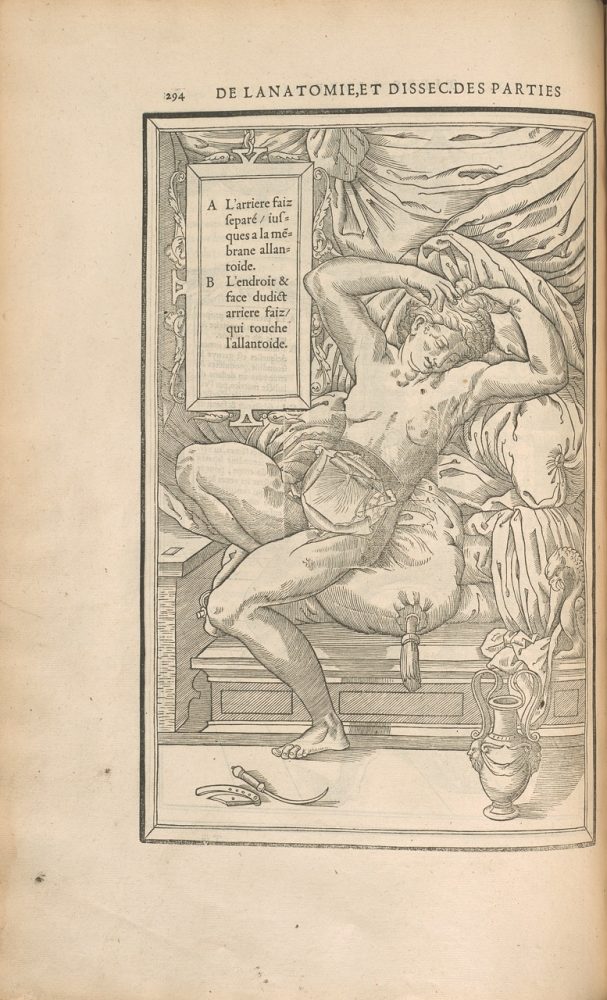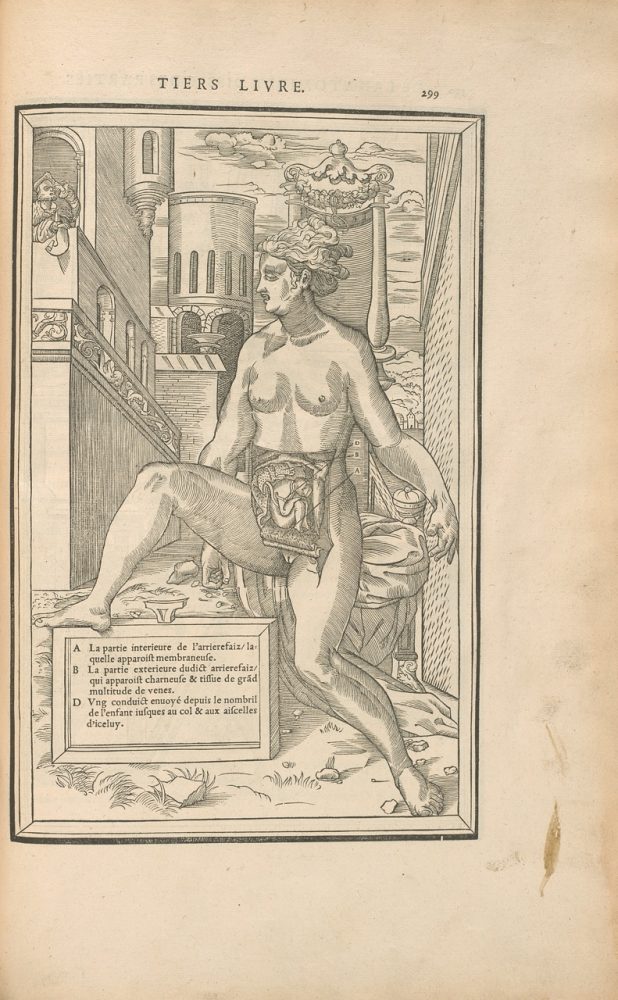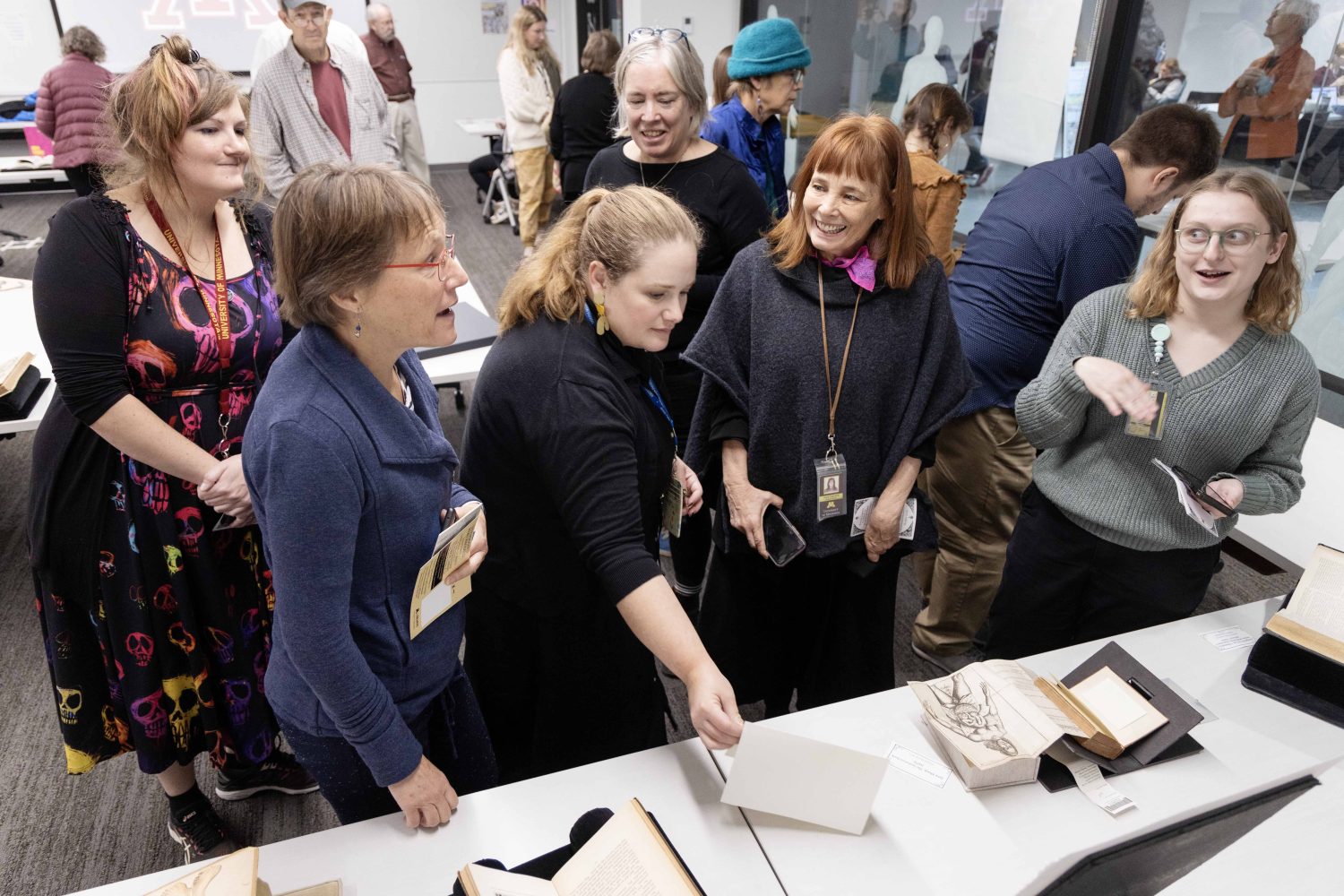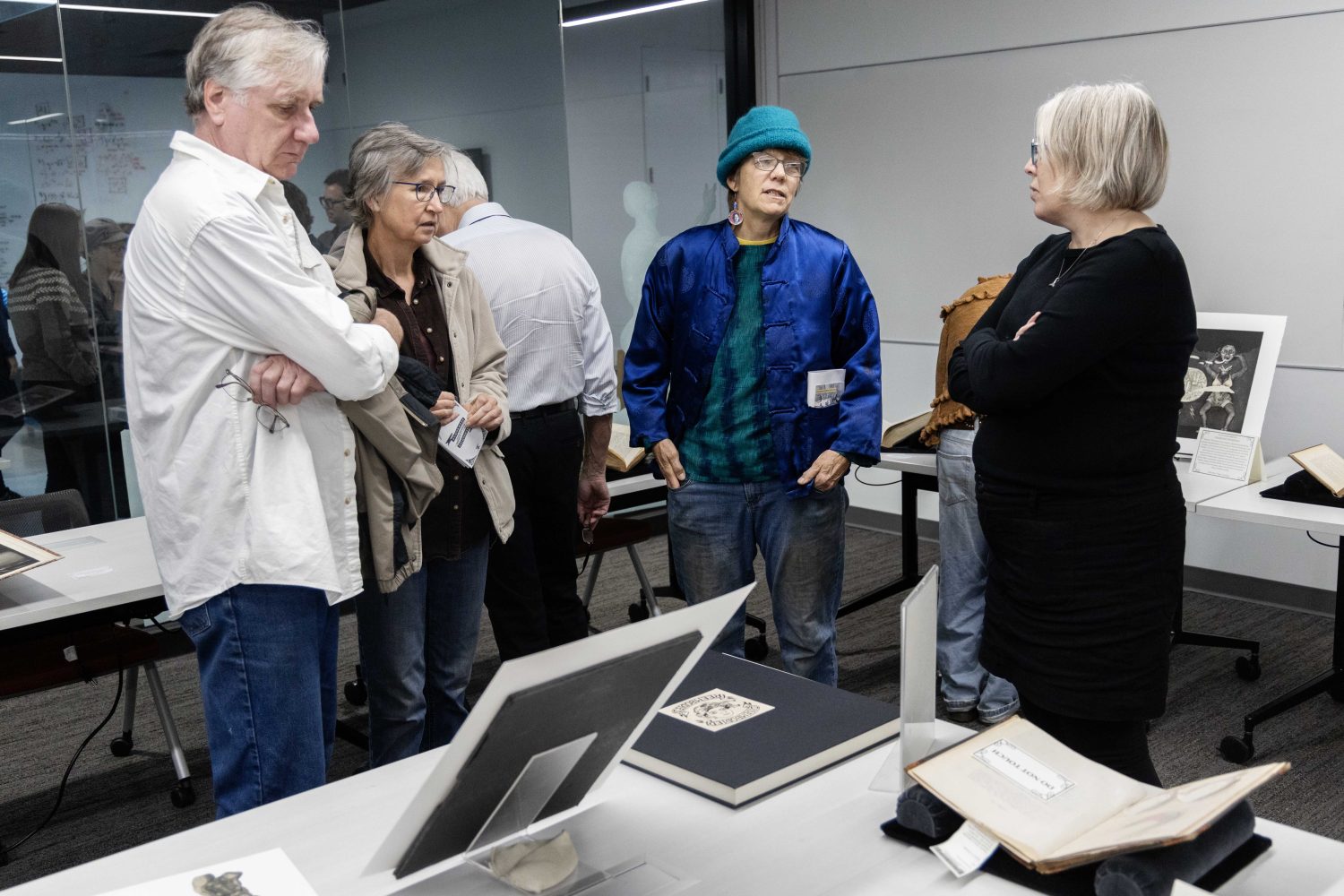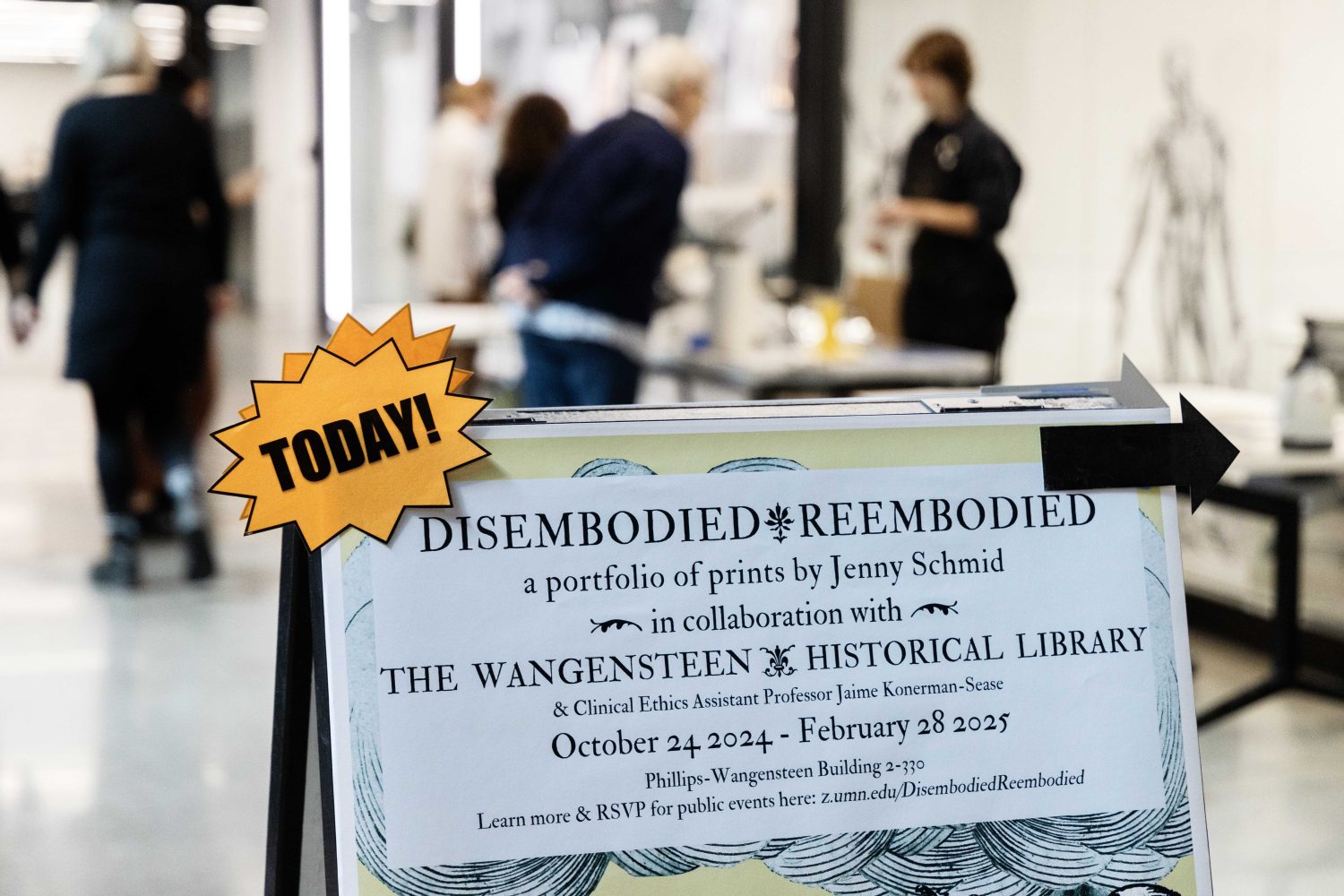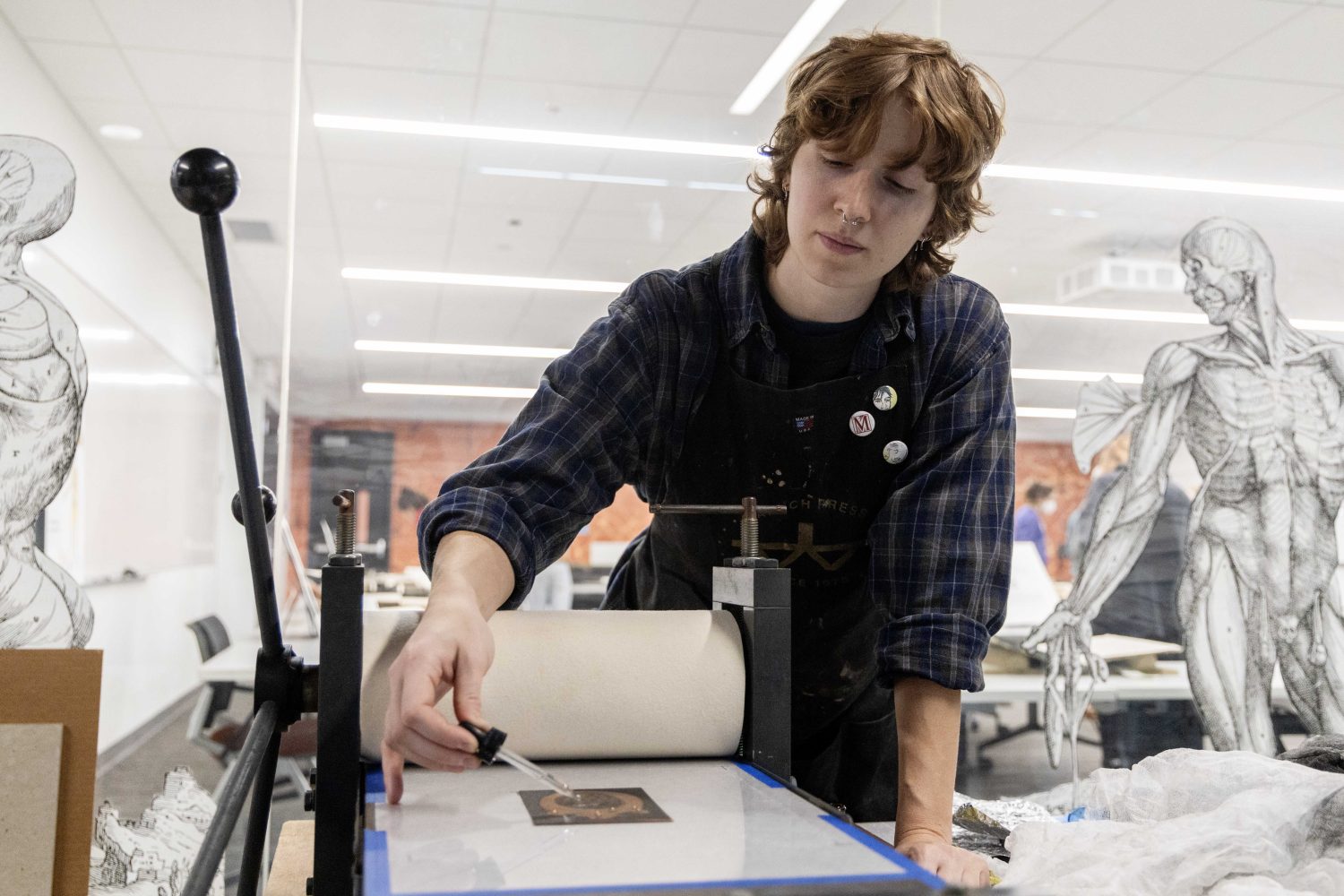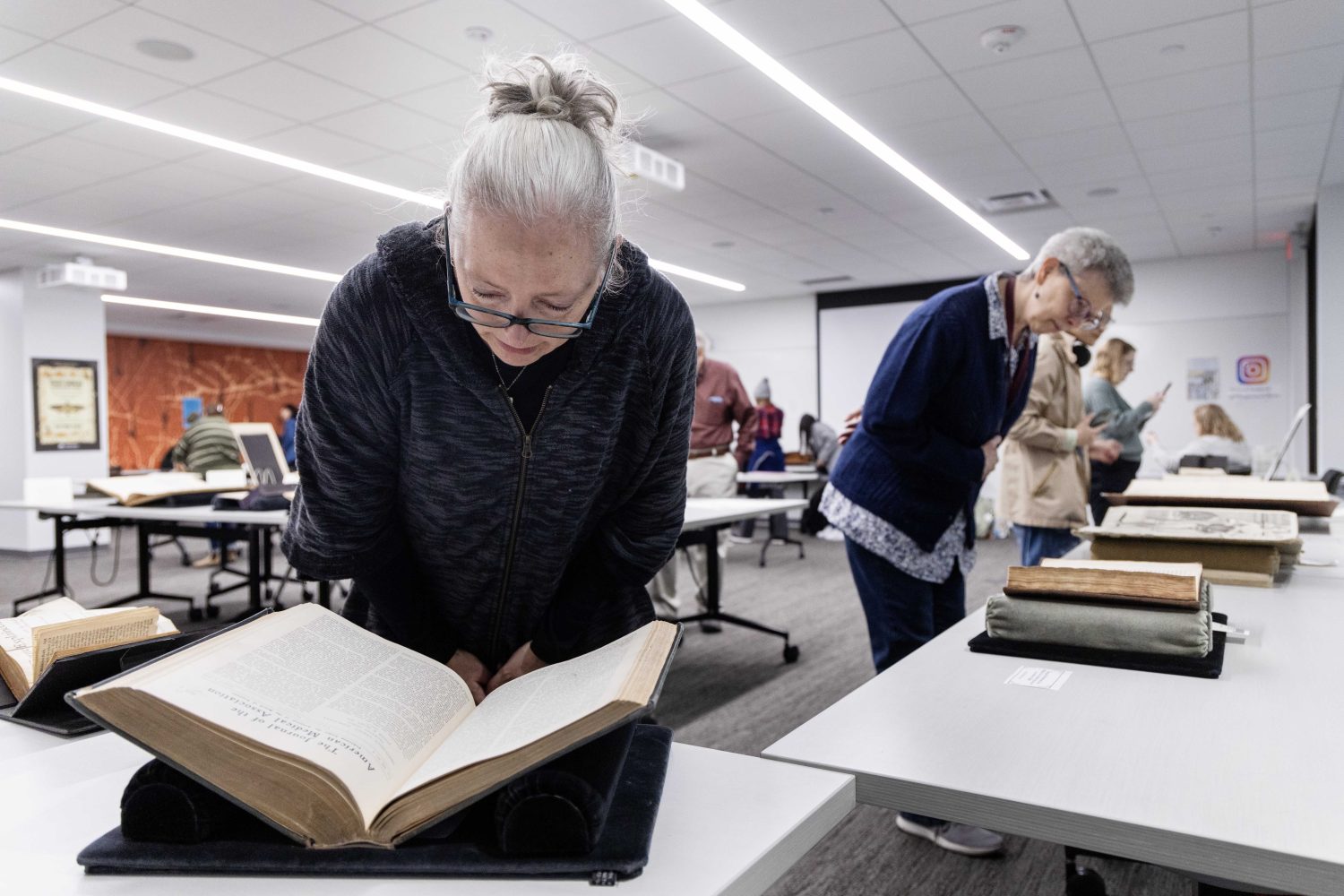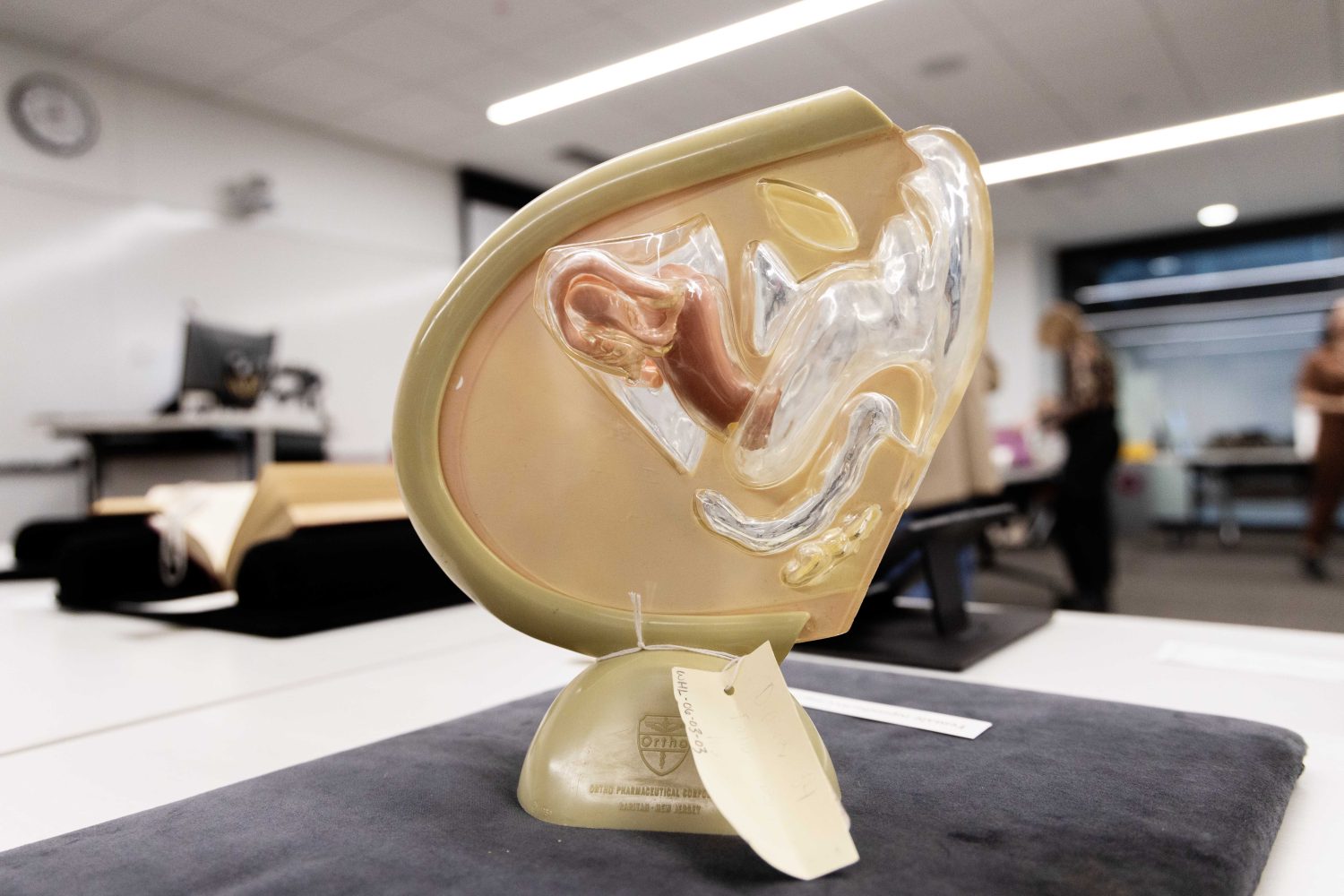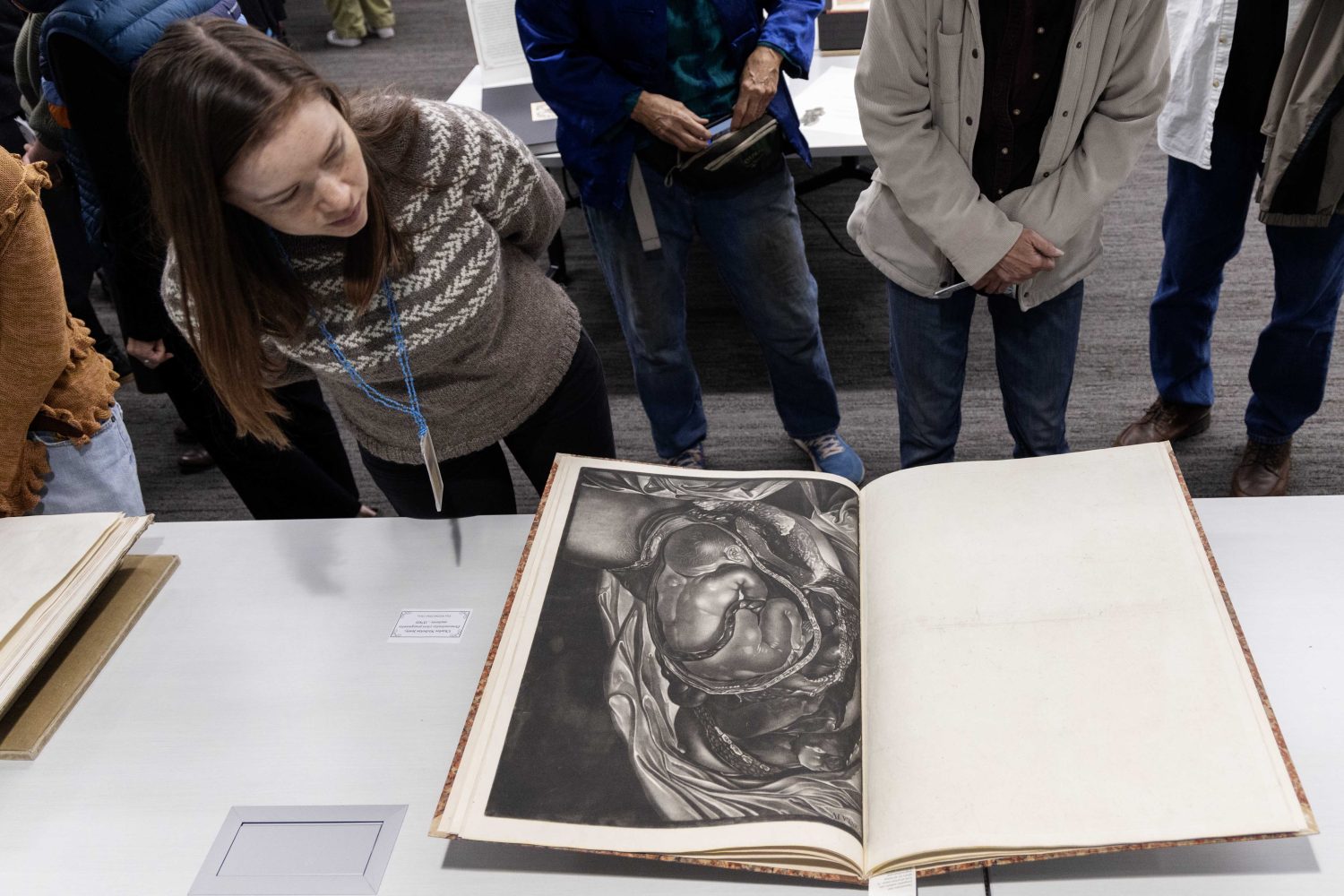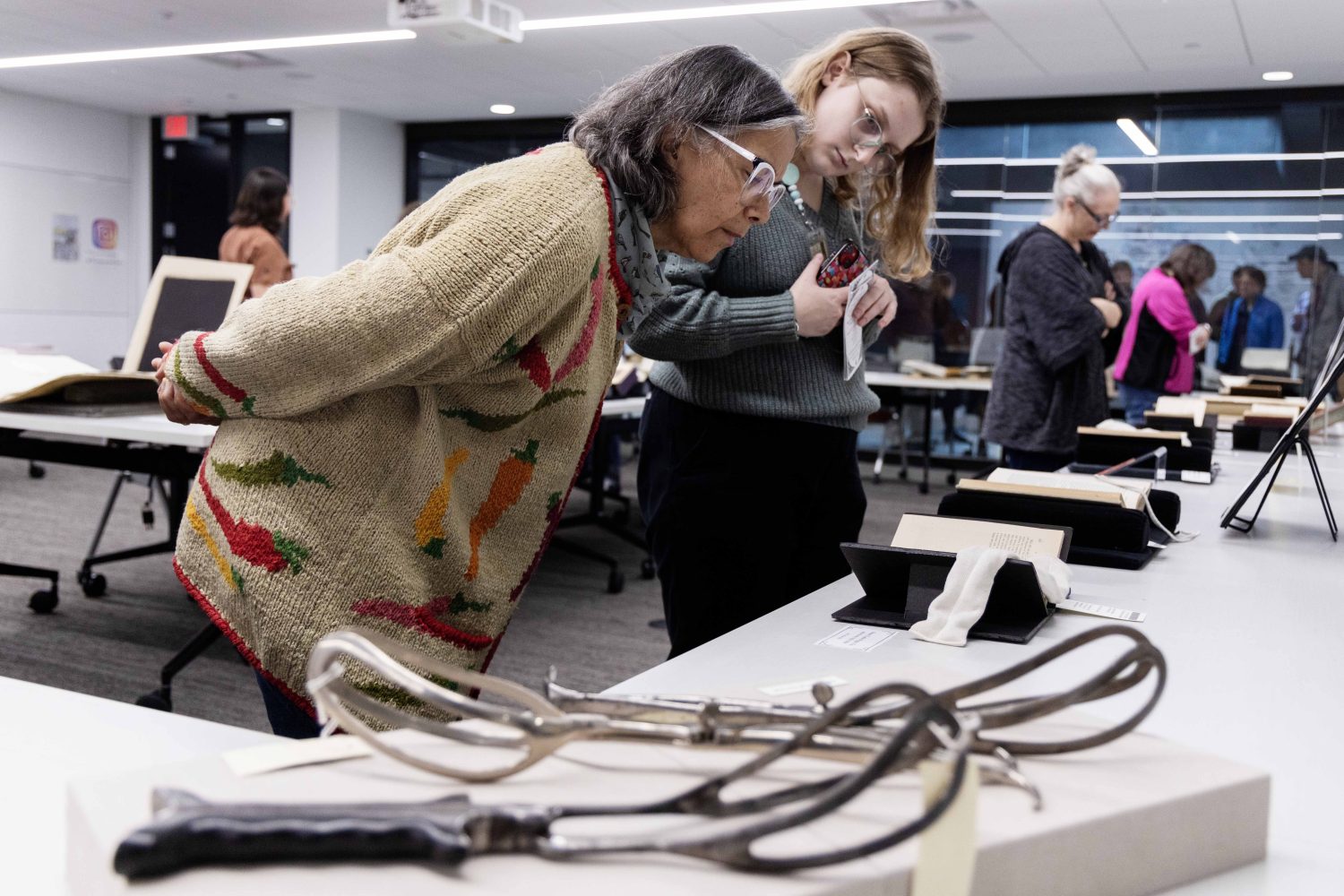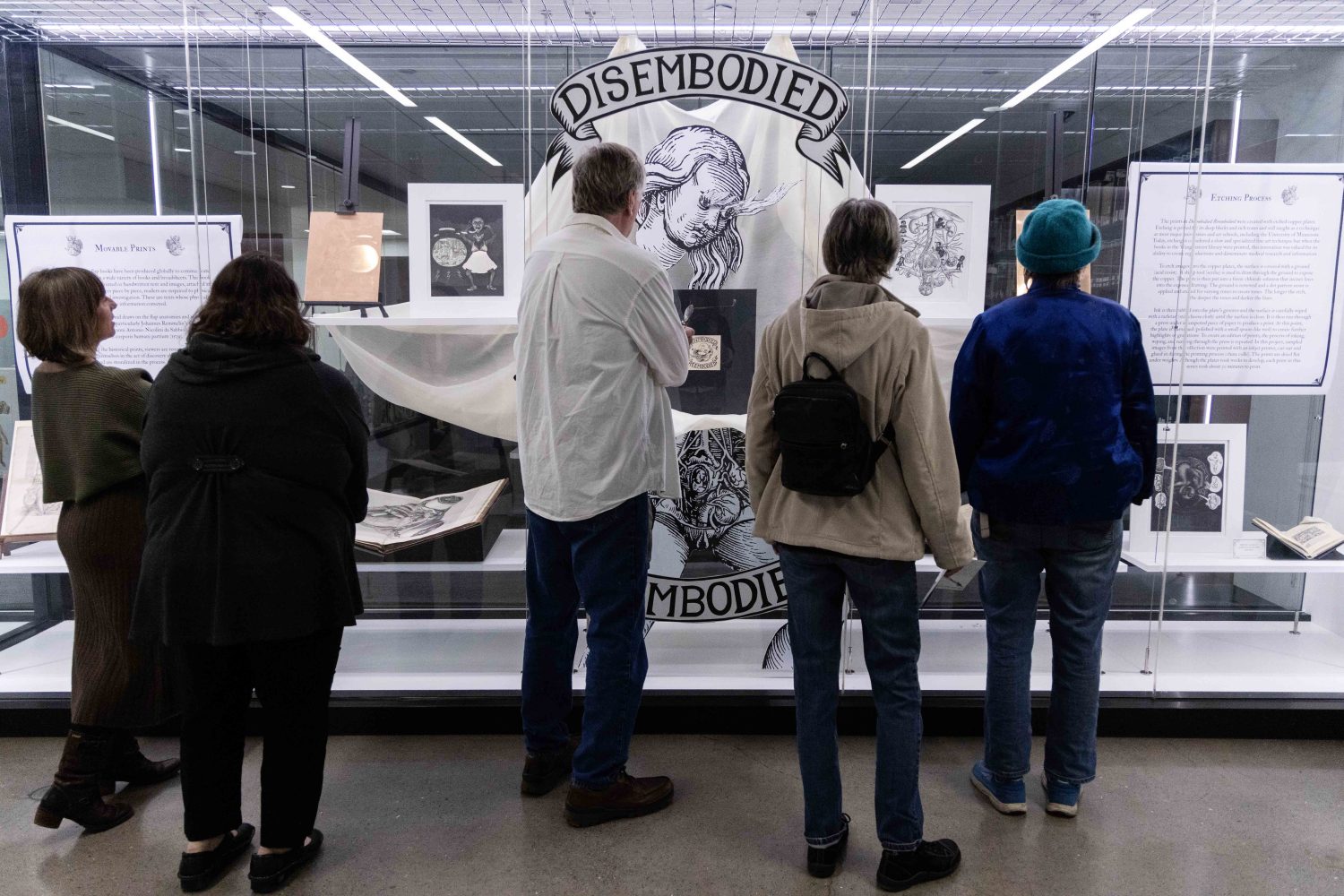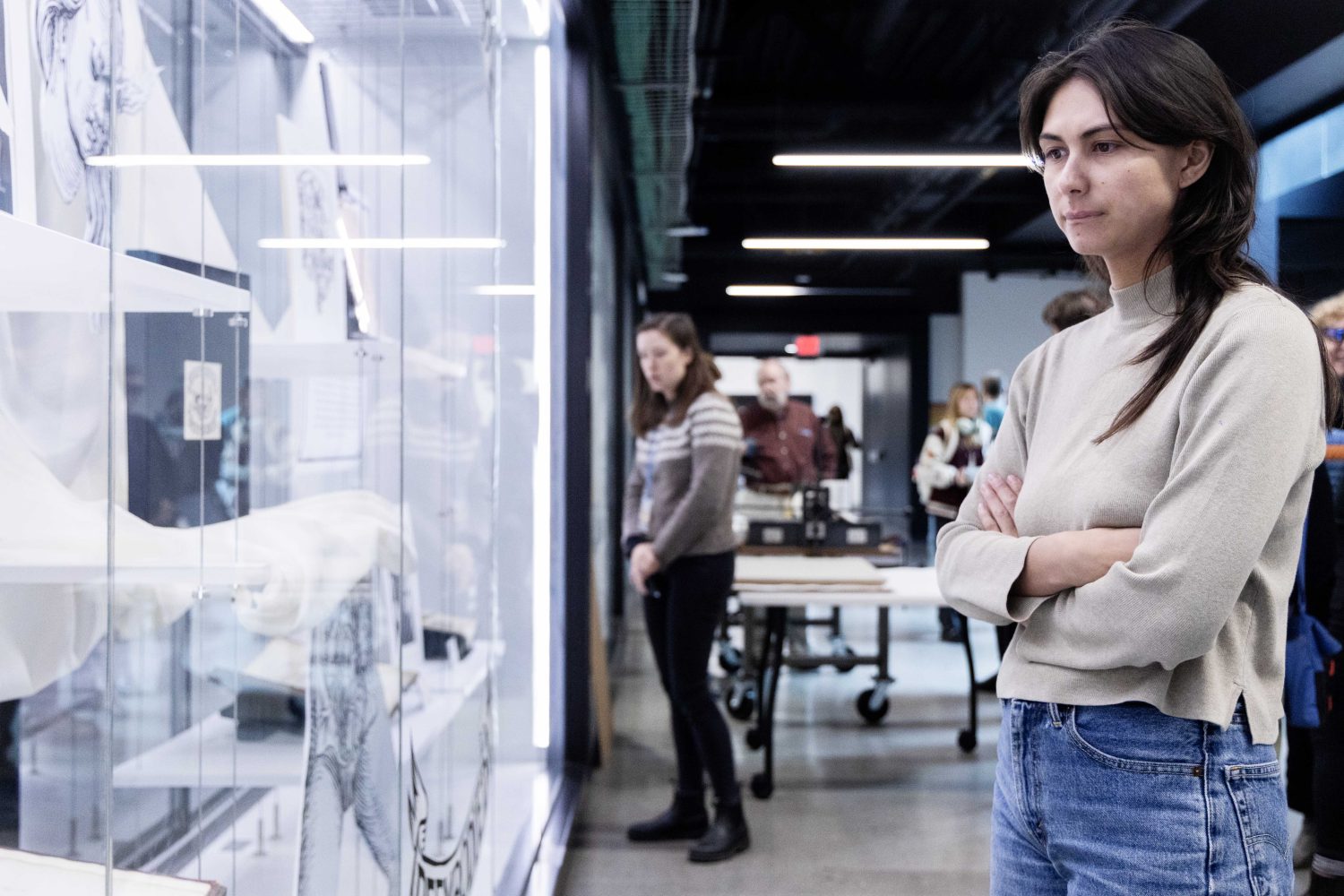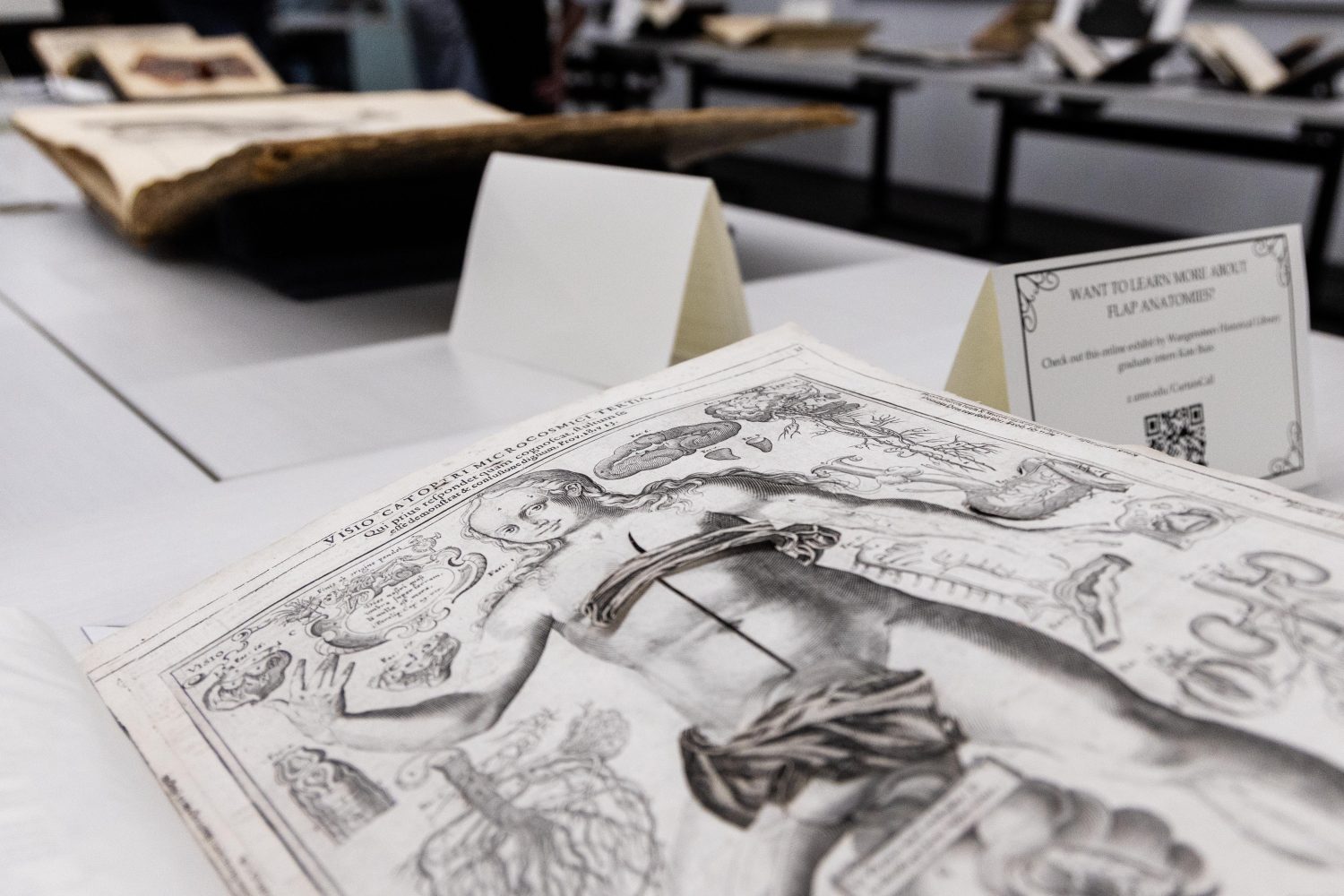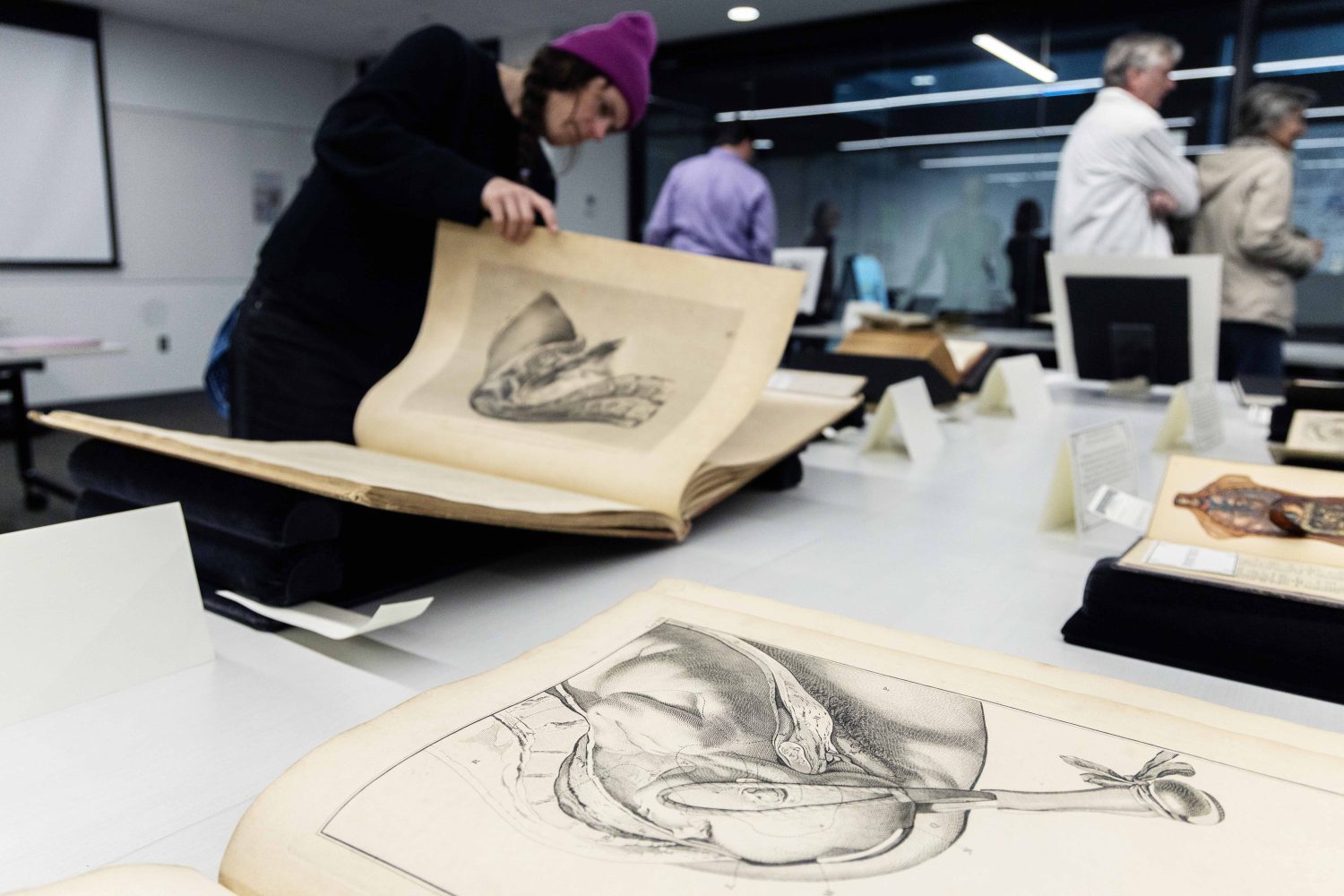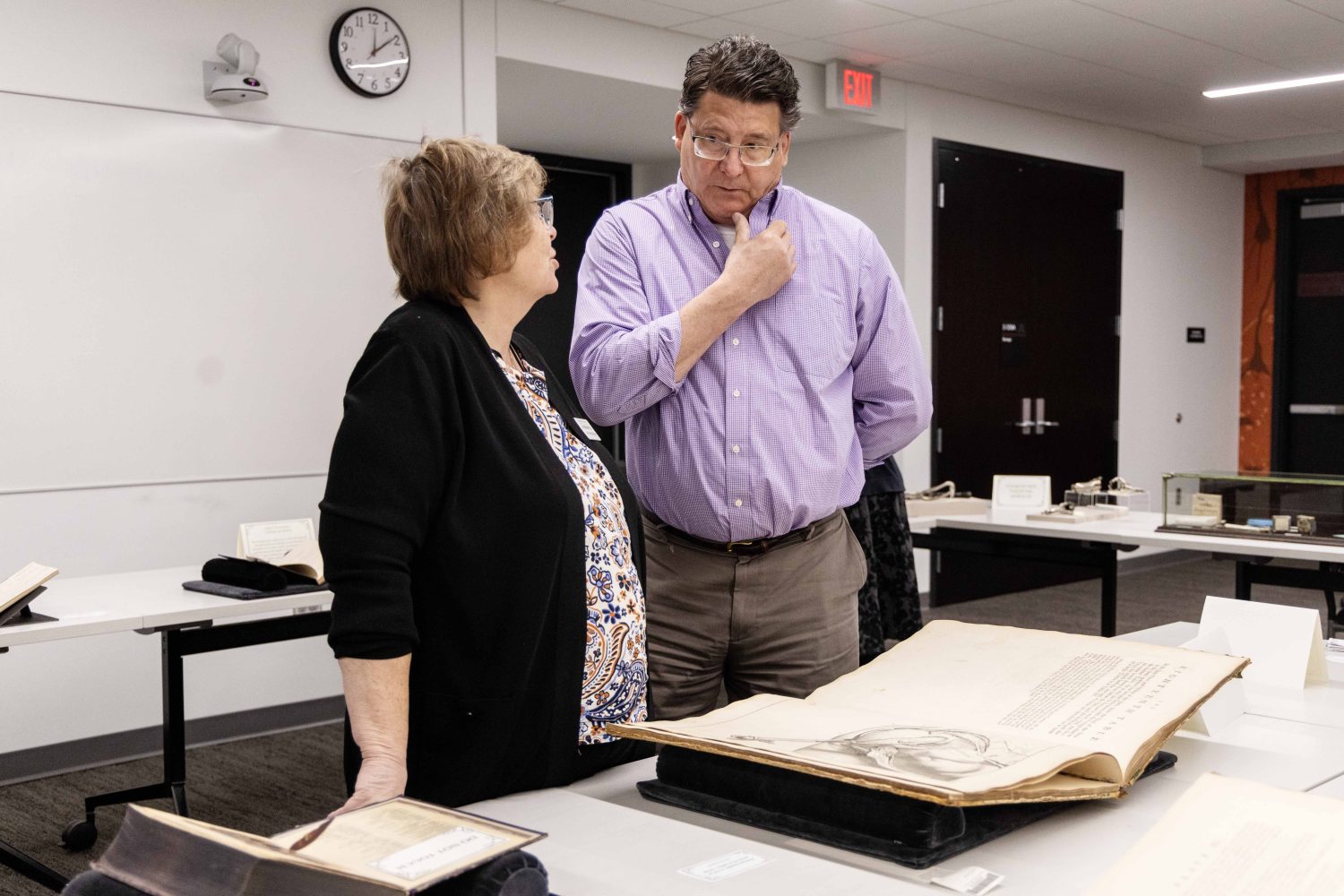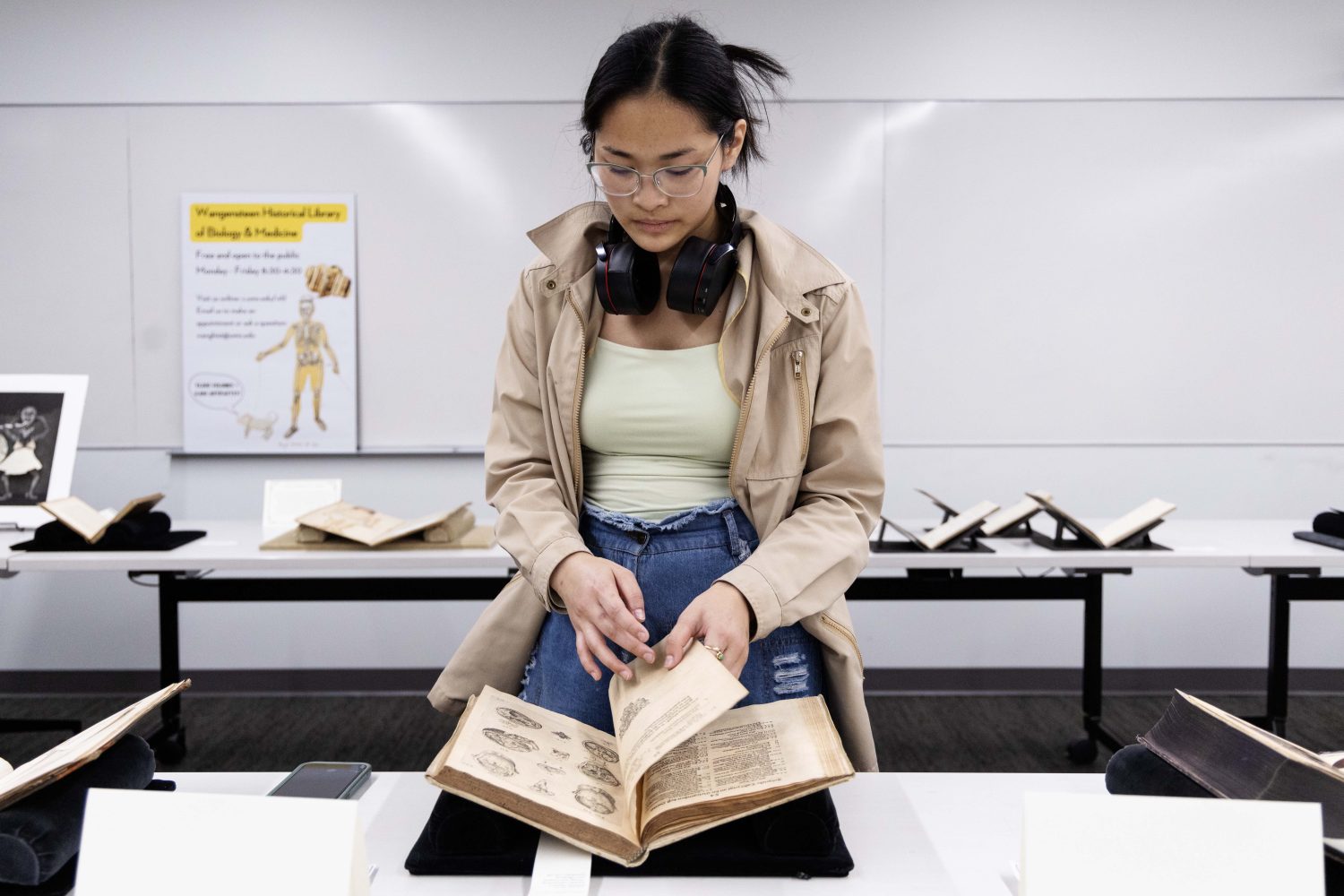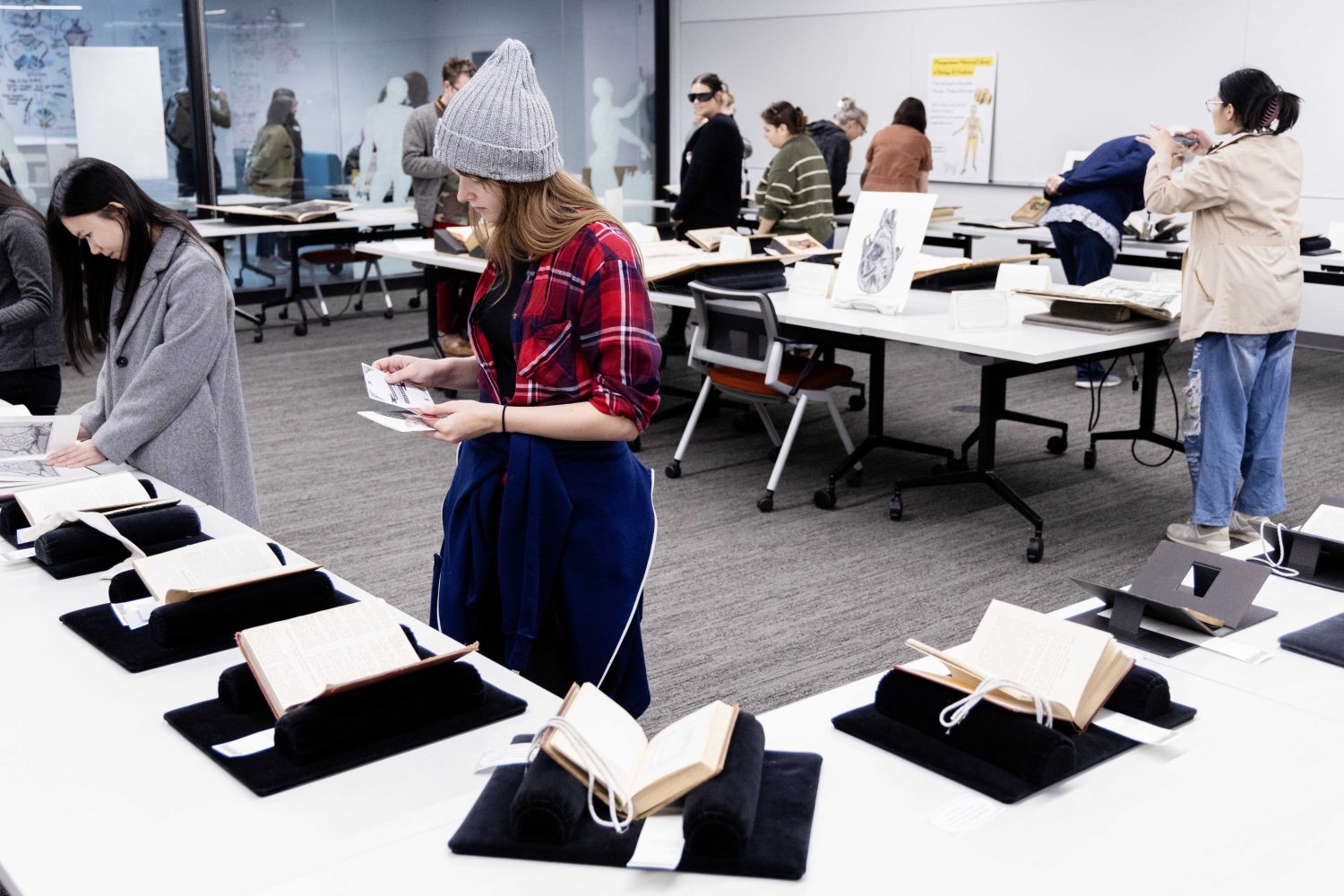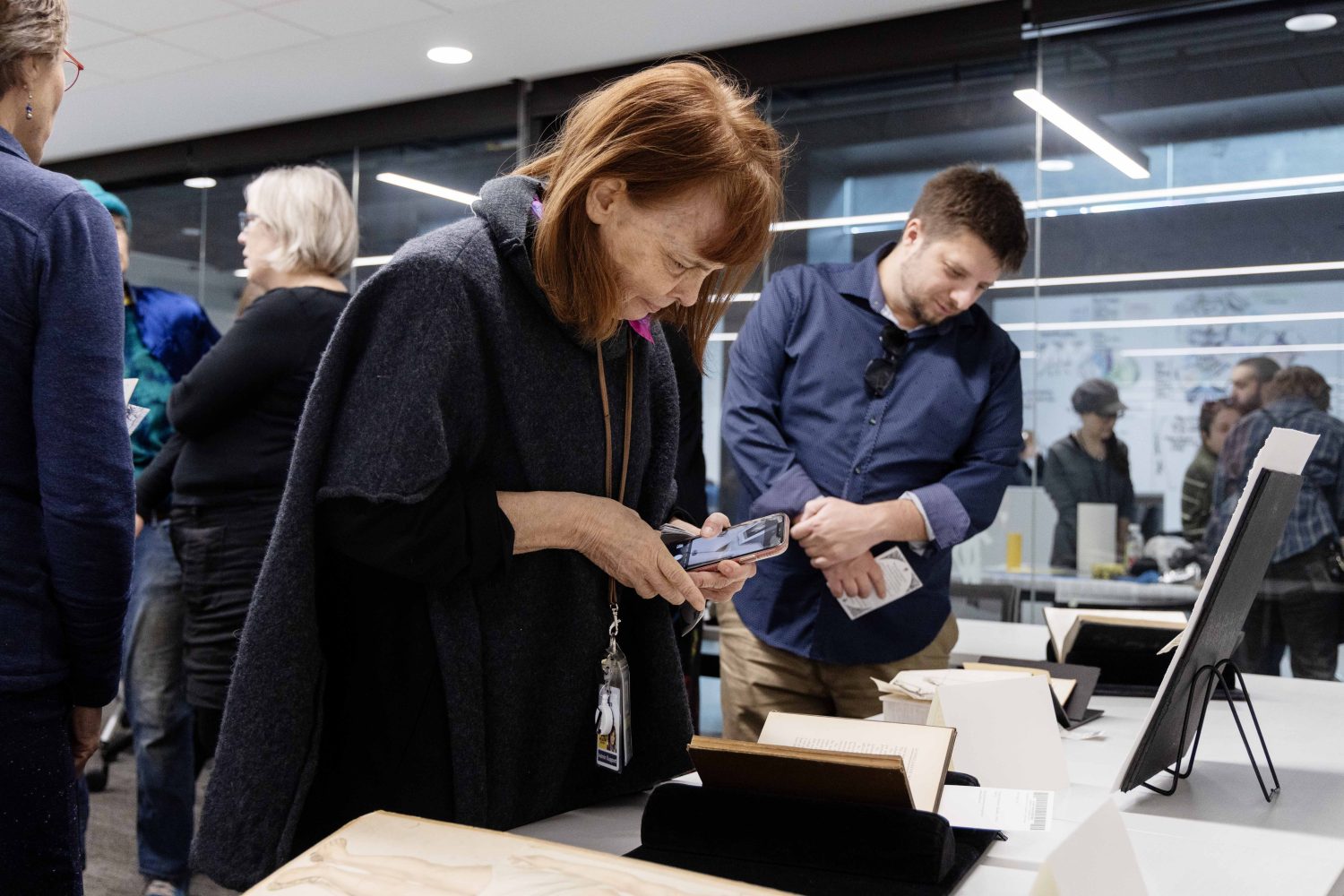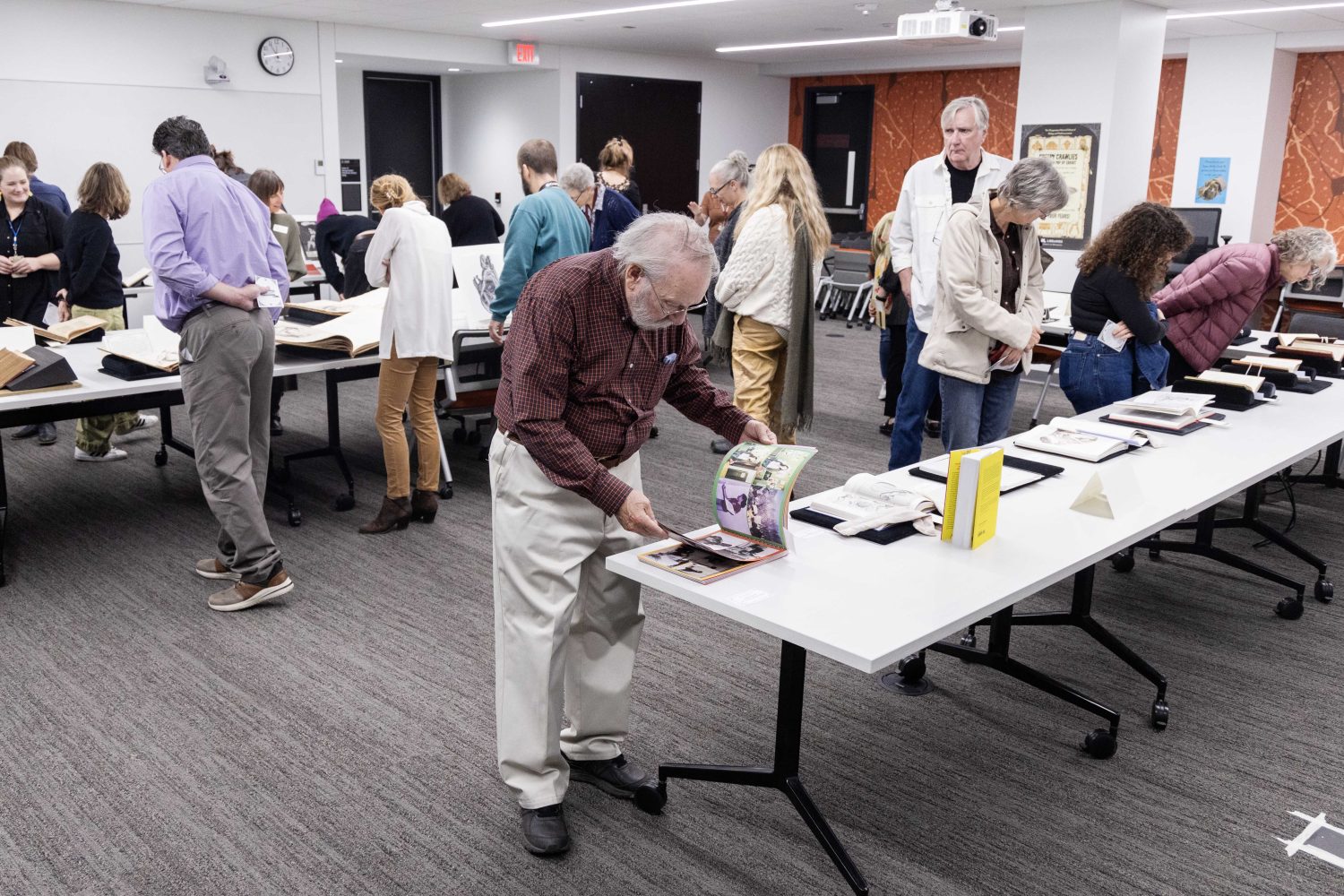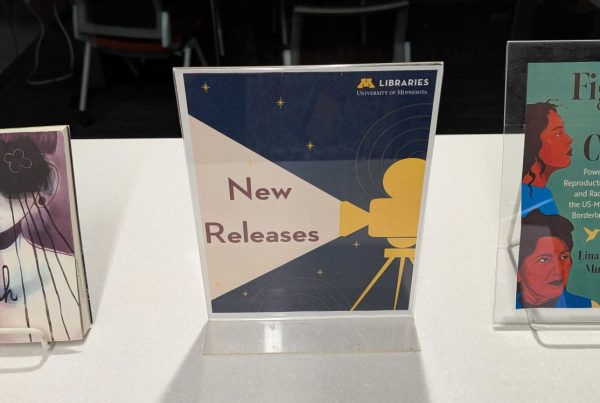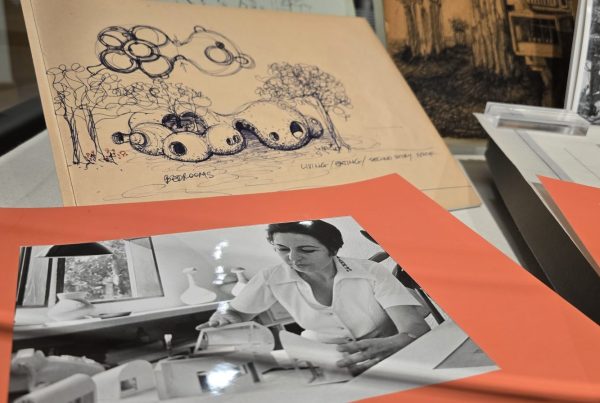Since the Dobbs v. Jackson Women’s Health Organization decision, which overturned Roe v. Wade, legislation restricting abortion and contraceptives has increased, coupled with growing maternal care deserts.
For Jenny Schmid, a professor of printmaking at the University of Minnesota, control of reproductive healthcare is reflected in medical literature, in how women’s bodies are segmented and dissected.
“It’s a particular image of a disembodied in-utero torso, basically like amputated legs and torso, that had some metaphorical resonance to me for contemporary ways in which politicians are talking about people’s bodies,” Schmid said.
- Hunter, William. Anatomia uteri humani gravidi tabula illustrata. Birmingham, 1774. Courtesy of the Wangensteen Historical Library
- One of Jenny Schmid’s prints created at the “Disembodied Reembodied” exhibit, on Thursday, October 24, 2024. (Photo/Adria Carpenter)
To recontextualize the pregnant body, Schmid collaborated with Emily Beck and Lois Hendrickson, curators of the Wangensteen Historical Library of Biology and Medicine, and Jaime Konerman-Sease, a clinical ethics assistant professor at the U of M, to create the folio and exhibit, “Disembodied Reembodied.”
“My goal is to activate the collection. So how can we place more of these materials in front of people, researchers, the public, through exhibits, outreach events, and scholarly investigations,” Hendrickson said. “And I think this project hits all of those things.”
The exhibit, currently on display at the Wangensteen, examines obstetrical images and depictions of women’s bodies from the library’s collection, spanning over 500 years of history, and considers how the medical gaze has affected the ways people receive care.
On Thursday, Nov. 14, the team will hold another exhibit reception at the Wangensteen Historical Library from 5 to 7 p.m., to discuss the prints, historical texts, and the project.
Dissecting the pregnant body
The oldest image the team found came from a German midwifery text from the early 16th century, which depicted a birthing room: a pregnant woman surrounded by three midwives, a bed prepared for her, and male astrologers reading the stars outside.
“I loved it because it seemed like the opposite of the kind of image you see in medical texts. There was nothing about organs, there was nothing about the reproductive system,” Konerman-Sease said. “But you can see that it is still educational, right? It’s understandable why it was included in this midwifery educational text.”
- Rüff, Jakob. De conceptu et generatione hominis. Francoforti ad Moenum, 1580. Courtesy of the Wangensteen Historical Library
- Rüff, Jakob. De conceptu et generatione hominis. Francoforti ad Moenum, 1580. Courtesy of the Wangensteen Historical Library
Looking through these images, you can see the progression of the scientific values, how prioritizing body parts over the whole – separating out the uterus and reproductive system – become stronger and stronger throughout the centuries, she explained. And in the process, context and community is lost.
“Why is the pregnant body so decontextualized? Why is it just focused on the event of reproduction? Where has the community gone? Where has the context gone?” Konerman-Sease said. “Jenny’s art is the recontextualization of that.”
The team found only two or three images of communities of care, since wealthy people who had access to the printing press became the voices of authority. Schmid was struck by one image that was originally pornographic, but was later repurposed as an anatomical print.
“There’s something really awkward about them that appealed to me. They’re not perfect ideas of beauty. A lot of these images are funny because they’ll have a very beautiful face and then they’re like a flayed body,” Schmid said. “For us, that was a little cabinet of curiosities, but then had some resonance around the politics of it.”
- Schenck, Johann Georg. Lithogenesia ; sive, De microcosmi membris petrefactis Francofurti, 1608. Courtesy of the Wangensteen Historical Library
- Colombo, R., & Schenck, J. A. (1609). Anatomia : das ist: [..] Durch Matthiam Becker, in Verlegung Theodori de Bry seligen Wittb, sampt zweyer Söhnen. Courtesy of the Wangensteen Historical Library
Schmid, who started fine art printmaking at age 16, said that practicing the medium that produced these books gives her the ability to communicate with history and reframe the discussion around feminist perspectives.
While printmaking isn’t the most efficient method of disseminating information, in light of the Internet, it has a tactile quality that demands people’s attention and uses that aura of history to comment on contemporary issues.
Schmid’s folio mixes original artwork with direct references to the Wangensteen’s collection, both visual and technical, like anatomical flap prints which gave a multilayered view on the human body and major organs. She sampled from the historical texts, made digital copies, and glued them onto her artwork during the printing process.
Her prints were created with etched copper plates, a technique that uses textured and polished surfaces to create shadows and highlights, respectively. The folio also includes essays from contributors alongside her artwork.
“Someone can look through it and have a casual experience with it, but if they want to, sit down and spend an hour with it. There’s a lot of material in there,” Schmid said.
- Estienne, C., & La Riviere, Etienne. (1546). De la dissection des parties du corps humain diuisée en trois liures. Courtesy of the Wangensteen Historical Library
- Estienne, C., & La Riviere, Etienne. (1546). De la dissection des parties du corps humain diuisée en trois liures. Courtesy of the Wangensteen Historical Library
Exploring medical values and collaborative care
The team is also using the folio and exhibit in the classroom, like in studio arts and Gender, Women, and Sexuality Studies.
“There’s a lot of opportunity for Jenny’s art to become a locus for exploration of values in medicine,” Konerman-Sease said. “Learning how to teach exploration of values I think is really part of that role of this work.”
Konerman-Sease said that this project is igniting conversation about gender and sexuality in the medical field, particularly in how we treat patients who don’t conform to the cisgender, white, heterosexual, male norm, and how values progressed from community and birthing person focused, to organ and body focused.
“People who are in clinical roles are actually hungry for this kind of exploration,” she said. “Frankly, med students don’t have a lot of opportunities to engage in critical thinking because there’s so much emphasis on having the correct factual knowledge at the drop of a hat. So [this is] reintroducing that critical thinking piece through art.”
- Emily Beck, curator of the Wangensteen Historical Library, speaks with guests at “Disembodied Reembodied” exhibit, on Thursday, October 24, 2024. (Photo/Adria Carpenter)
- Jenny Schmid (right) speaks with guests at “Disembodied Reembodied” exhibit, on Thursday, October 24, 2024. (Photo/Adria Carpenter)
After pushing people to place an analytical lens over these historical images, Konerman-Sease ties them to contemporary cases she’s overseen in the M Health Fairview system – where she provides clinical ethics consultation and policy development – asking how we might recontextualize a real life situation.
“What does it mean to participate with that birthing person rather than enacting care upon that birthing person?” she said.
For Hendrickson and Beck, students don’t always understand why these texts were expensive or considered luxury items and status symbols, since books today are cheap and accessible. But after learning about the printmaking process, the weeks and months behind developing these copper plates, they understand the effort and expertise it requires.
“It’s really gratifying, for someone who spends hours and hours alone in my studio, to know that people are looking closely at things you’ve been looking closely at, and thinking really deeply about them as well,” Schmid said. “Looking critically at images is just so important.”
Cross-disciplinary projects and exhibit reception
“Disembodied Reembodied” was funded by the Research and Innovation Office’s inaugural Art and Science Grant, awarded late 2023. The grant allowed the Wangensteen to have a depth of collaboration outside their normal work, Beck explained.
While Schmid was already a frequent visitor to the Wangensteen, Beck and Hendrickson didn’t have the time or resources to complete a project like this, which will reach people from different backgrounds and disciplines. So the grant was “really critical,” Beck said.
“It’s a good high-impact demonstration of why we need more cross-disciplinary work here at the University,” Hendrickson said.
The project was also made possible by Sydney Petersen, Schmid’s printing assistant, who masterminded the window display and operated the printmaking demonstration at the exhibit opening.
Oscar Chuba and Juliana Christ, two undergraduate interns and members of the Dean’s First-Year Research and Creative Scholars Program, helped comb through the Wangensteen’s holding and find relevant materials.
“Disembodied Reembodied” also has an accompanying zine made by Ivy Bolthouse, which communicates the ideas of the exhibit in a new and accessible format.
- The Wangensteen Historical Library’s exhibit “Disembodied Reembodied,” on Thursday, October 24, 2024. (Photo/Adria Carpenter)
- Sydney Petersen, a printing assistant, demonstrates how prints are made at the Wangensteen Historical Library’s exhibit “Disembodied Reembodied,” on Thursday, October 24, 2024. (Photo/Adria Carpenter)
- Attendees examine materials from the Wangensteen Historical Library’s exhibit “Disembodied Reembodied,” on Thursday, October 24, 2024. (Photo/Adria Carpenter)
- A diagram of a womb from the Wangensteen Historical Library’s exhibit “Disembodied Reembodied,” on Thursday, October 24, 2024. (Photo/Adria Carpenter)
- Attendees examine materials from the Wangensteen Historical Library’s exhibit “Disembodied Reembodied,” on Thursday, October 24, 2024. (Photo/Adria Carpenter)
- Patricia Izek, director of Diversity, Equity, Inclusion and Accessibility at University of Minnesota Libraries, examines materials from the Wangensteen Historical Library’s exhibit “Disembodied Reembodied,” on Thursday, October 24, 2024. (Photo/Adria Carpenter)
- Attendees examine materials from the Wangensteen Historical Library’s exhibit “Disembodied Reembodied,” on Thursday, October 24, 2024. (Photo/Adria Carpenter)
- Attendees examine materials from the Wangensteen Historical Library’s exhibit “Disembodied Reembodied,” on Thursday, October 24, 2024. (Photo/Adria Carpenter)
- Attendees examine materials from the Wangensteen Historical Library’s exhibit “Disembodied Reembodied,” on Thursday, October 24, 2024. (Photo/Adria Carpenter)
- A flap print of human anatomy from materials in the “Disembodied Reembodied” exhibit, on Thursday, October 24, 2024. (Photo/Adria Carpenter)
- Lois Hendrickson, curator of the Wangensteen Historical Library, speaks with guests at “Disembodied Reembodied” exhibit, on Thursday, October 24, 2024. (Photo/Adria Carpenter)
- Attendees examine materials from the Wangensteen Historical Library’s exhibit “Disembodied Reembodied,” on Thursday, October 24, 2024. (Photo/Adria Carpenter)
- Sydney Petersen, a printing assistant, demonstrates how prints are made at the Wangensteen Historical Library’s exhibit “Disembodied Reembodied,” on Thursday, October 24, 2024. (Photo/Adria Carpenter)
- Lois Hendrickson, curator of the Wangensteen Historical Library, speaks with guests at “Disembodied Reembodied” exhibit, on Thursday, October 24, 2024. (Photo/Adria Carpenter)
- Attendees examine materials from the Wangensteen Historical Library’s exhibit “Disembodied Reembodied,” on Thursday, October 24, 2024. (Photo/Adria Carpenter)
- Attendees examine materials from the Wangensteen Historical Library’s exhibit “Disembodied Reembodied,” on Thursday, October 24, 2024. (Photo/Adria Carpenter)
- Attendees examine materials from the Wangensteen Historical Library’s exhibit “Disembodied Reembodied,” on Thursday, October 24, 2024. (Photo/Adria Carpenter)
- Attendees examine materials from the Wangensteen Historical Library’s exhibit “Disembodied Reembodied,” on Thursday, October 24, 2024. (Photo/Adria Carpenter)


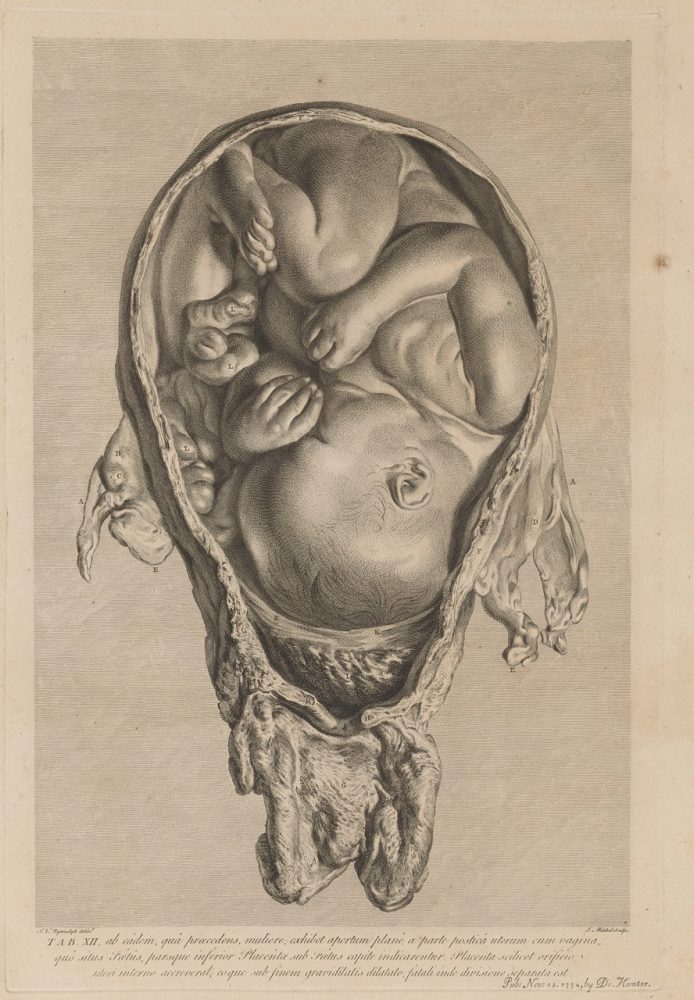
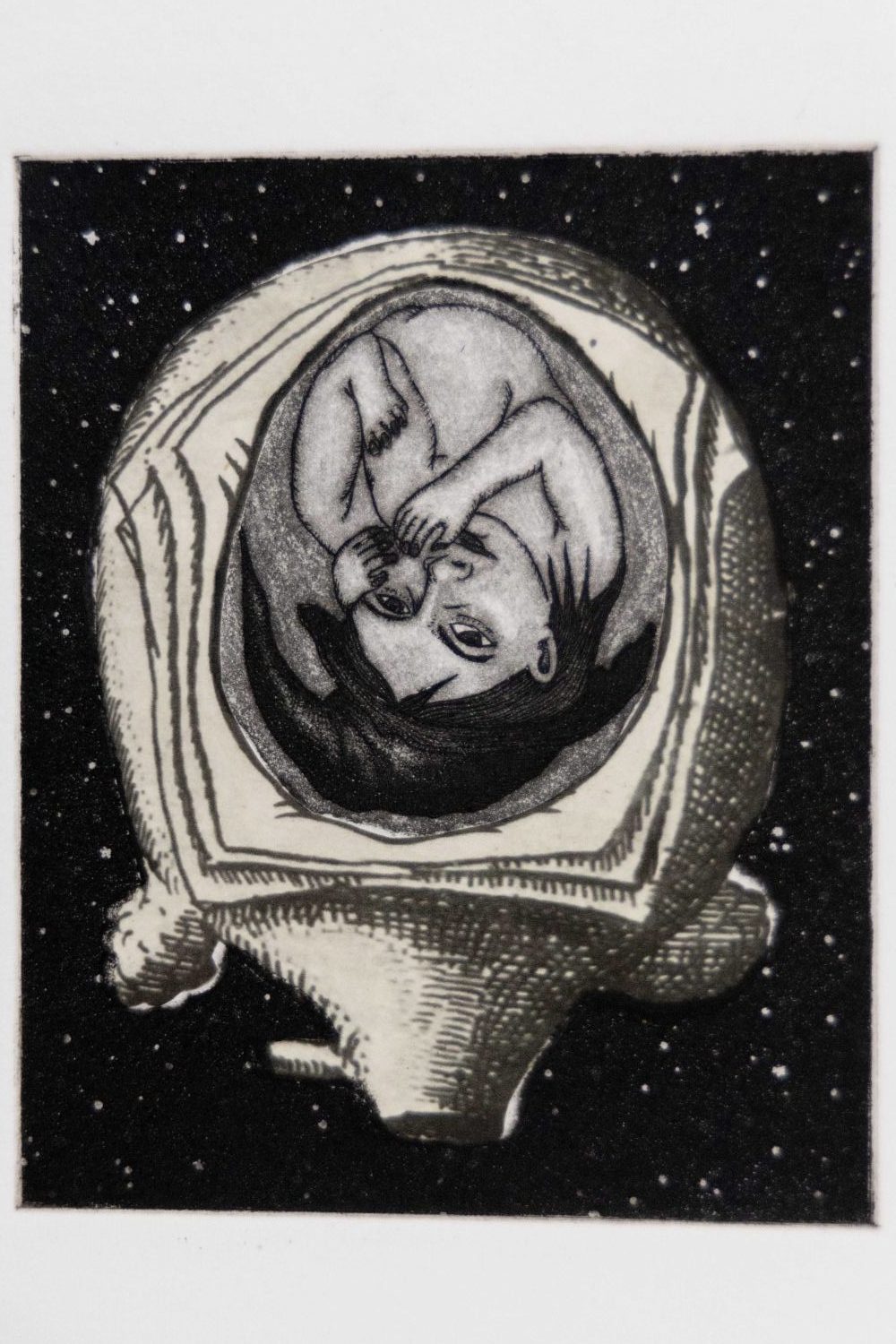
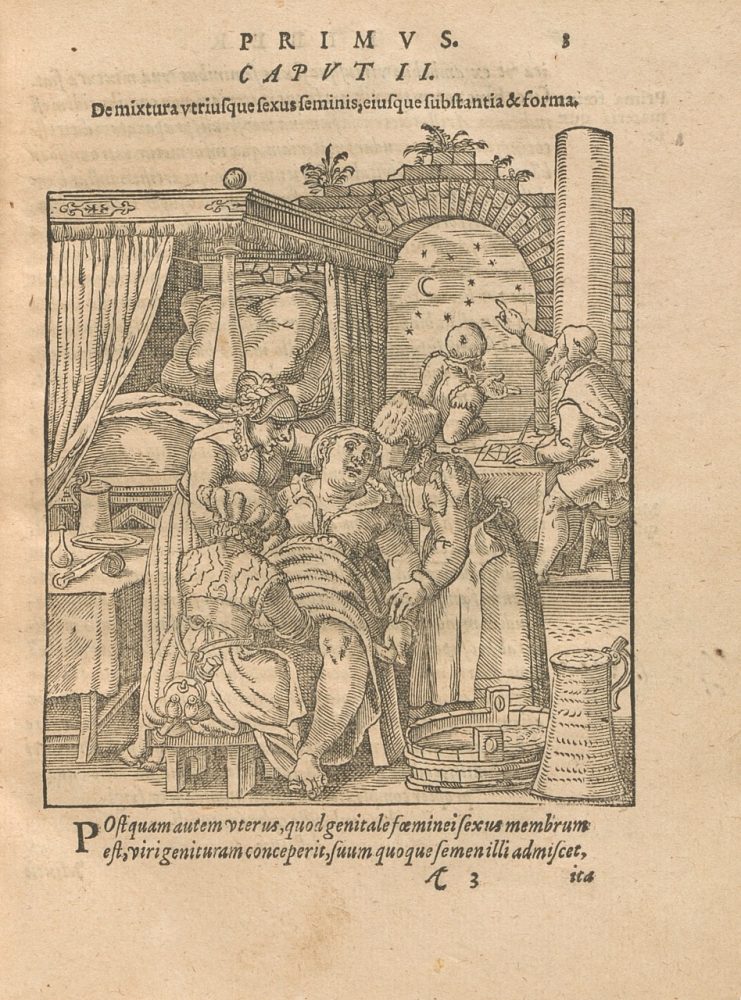

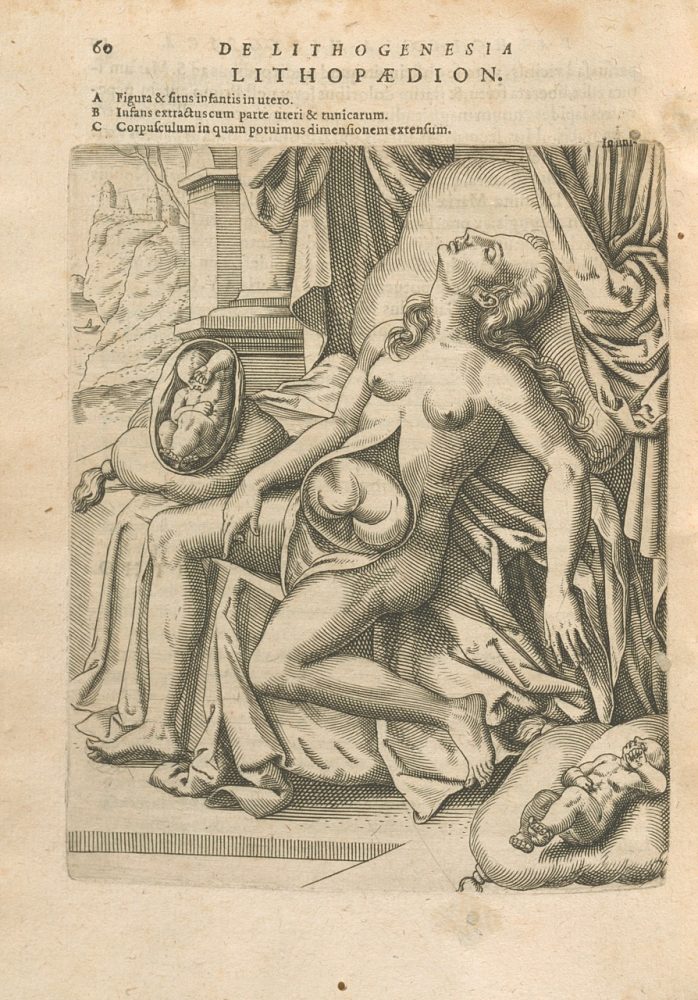
![Colombo, R., & Schenck, J. A. (1609). Anatomia : das ist: [..] Durch Matthiam Becker, in Verlegung Theodori de Bry seligen Wittb, sampt zweyer Söhnen. Courtesy of the Wangensteen Historical Library](https://libnews.umn.edu/wp-content/uploads/2024/11/wan45072-Grande.jpeg)
